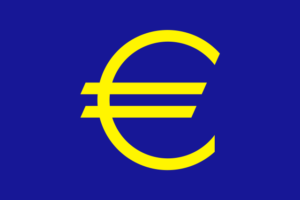On April 19, the European Parliament gave its approval (by 574 votes to 13) to a 5th update of anti-money laundering regulations, this time adding art and antiques dealers to its Annex III categories of business at high risk for involvement in money-laundering. In a press release on May 23, 2018, the European Commission stated that the “reinforced rules… work to fight the financing of terrorism.”
The regulations will require art dealers to identify clients and document and report all transactions of €10,000 or more, regardless of whether the transaction is in cash, check, credit card, or other form of payment.

Flag of Euro, By Todofai, via Wikimedia Commons.
The European Parliament and the Council are expected to endorse the EU directive later this year. EU member states will then need to adapt their own financial regulations to incorporate all the changes since the 4th directive. They are allowed 18 months to transpose the new rules into national law and set up new systems to implement them.
CINOA, a confederation of nineteen EU and ten other international art and antique dealer associations, has strongly objected to this unprecedented inclusion of art dealers in anti-money laundering regulations. In a statement released on April 3, CINOA noted that art dealers were added to the high risk category without consultation with the industry and without any evidence that the art trade was involved with terrorists or criminal trafficking.
Despite the lack of evidence of a terrorist connection to the art trade (in fact, in contradiction to the results of its own commissioned research), the EU has approved the proposed update. (See: Ivan Macquisten, No EU problem with terrorist antiquities, so let’s legislate for it, Cultural Property News, September 21, 2017.)
No EU problem with terrorist antiquities, so let’s legislate for it
There is also further EU legislation in the works that will place impossible-to-meet documentary requirements for the importation of a wide range of international cultural property into the EU. (See: Proposed EU Rules on Asian, Islamic, and Antiquities Trade, Cultural Property News, April 22, 2018.)
The EU statement noted that the regulation’s stated goal is to halt large cash flows involving criminal activities in the EU and worldwide. However, CINOA noted that its members are already subject to reporting requirements for €10,000 cash transactions, and that the new regulations will cover ALL transactions, even check, credit card, or wire transfer sales.
CINOA’s secretary general Erika Bochereau said the bill was based upon false assumptions about the art trade. She noted that most antiques businesses are small, and the regulations will hamper their operations without providing a benefit in terms of reducing the threat of terrorist or criminal activity.
British Art Market Federation (BAMF) president Anthony Browne told the Antiques Trade Gazette that the group is continuing to consult with the government in order to try and safeguard small businesses from burdensome reporting.
The new EU regulations will also cover people entering or leaving the EU with €10,000 or more in cash, traveler’s checks, and negotiable instruments (the U.S. already requires such reporting by persons carrying $10,000 or more in cash). It will allow customs to hold for inquiry large amounts of cash even below this threshold, and will “extend customs controls to cash sent in postal parcels or freight shipments, to prepaid cards and to precious commodities such as gold, which are not currently subject to customs control.”
It is not known how Brexit will affect implementation of the rule in the UK.
 European Parliament, By Diliff, Wikimedia Commons
European Parliament, By Diliff, Wikimedia Commons 

